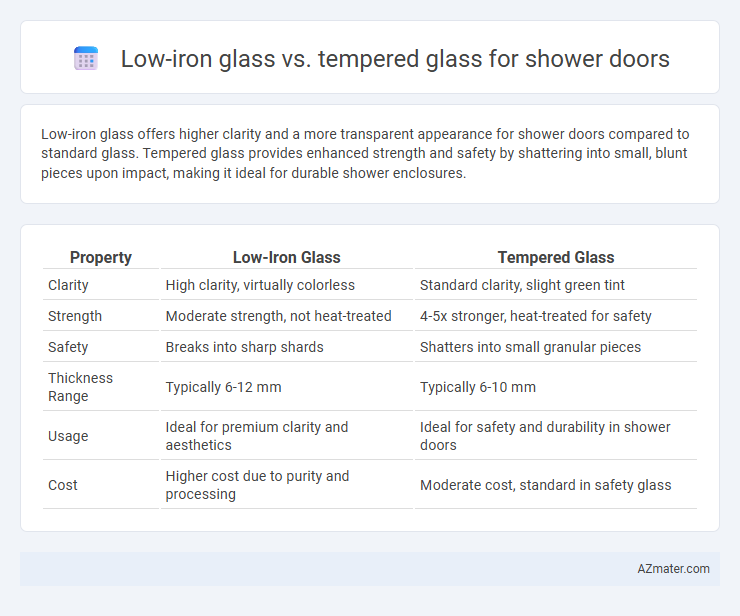Low-iron glass offers higher clarity and a more transparent appearance for shower doors compared to standard glass. Tempered glass provides enhanced strength and safety by shattering into small, blunt pieces upon impact, making it ideal for durable shower enclosures.
Table of Comparison
| Property | Low-Iron Glass | Tempered Glass |
|---|---|---|
| Clarity | High clarity, virtually colorless | Standard clarity, slight green tint |
| Strength | Moderate strength, not heat-treated | 4-5x stronger, heat-treated for safety |
| Safety | Breaks into sharp shards | Shatters into small granular pieces |
| Thickness Range | Typically 6-12 mm | Typically 6-10 mm |
| Usage | Ideal for premium clarity and aesthetics | Ideal for safety and durability in shower doors |
| Cost | Higher cost due to purity and processing | Moderate cost, standard in safety glass |
Introduction: Understanding Shower Door Glass Options
Low-iron glass offers enhanced clarity and a brighter appearance due to its reduced iron content, making it ideal for modern shower doors that emphasize visual aesthetics. Tempered glass, known for its superior strength and safety, undergoes a heat-treatment process that increases its durability and prevents dangerous shards upon breakage. Choosing between low-iron and tempered glass depends on balancing the desire for crystal-clear transparency with the need for robust safety features in shower doors.
What is Low-Iron Glass?
Low-iron glass is a type of glass with reduced iron content, resulting in higher clarity and a more transparent appearance compared to standard glass. Its low iron oxide content minimizes the greenish tint found in regular glass, making it ideal for shower doors where aesthetics and light transmission are important. Unlike tempered glass, which undergoes heat treatment for strength, low-iron glass emphasizes optical clarity but can be tempered for safety applications in bathrooms.
What is Tempered Glass?
Tempered glass for shower doors is a type of safety glass processed by controlled thermal or chemical treatments to increase its strength compared to standard glass. When broken, it shatters into small, blunt pieces to reduce the risk of injury, making it an ideal choice for bathroom environments. Unlike low-iron glass, which emphasizes clarity and color neutrality, tempered glass prioritizes durability and safety without compromising visual appeal.
Clarity and Color: Visual Differences
Low-iron glass offers superior clarity and a true, colorless appearance, enhancing the brightness and modern aesthetic of shower doors. Tempered glass typically has a slight green tint due to its iron content, which can subtly alter the bathroom's color scheme. For those prioritizing visual purity and a sleek, transparent look, low-iron glass is the optimal choice over standard tempered glass.
Strength and Safety Features
Tempered glass for shower doors offers superior strength, being heat-treated to withstand impacts up to four to five times greater than standard glass, reducing breakage risk. Low-iron glass enhances clarity and aesthetic appeal but does not inherently improve structural strength or safety; it typically requires tempering to meet safety standards. Both types prioritize safety by breaking into small, blunt pieces upon impact, but tempered low-iron glass combines enhanced durability with clearer, more vibrant visuals for shower enclosures.
Cost Comparison: Low-Iron vs Tempered Glass
Low-iron glass typically costs 20-40% more than tempered glass due to its higher clarity and reduced green tint, making it an upscale choice for shower doors. Tempered glass, which undergoes heat treatment for safety, remains a more budget-friendly option, commonly priced between $25 and $50 per square foot. The cost difference reflects not only material quality but also processing techniques, with low-iron glass appealing to homeowners seeking premium aesthetics despite the higher price.
Maintenance and Durability
Low-iron glass offers enhanced clarity and resists discoloration, making it easier to maintain its pristine appearance with regular cleaning using non-abrasive, pH-neutral solutions. Tempered glass provides superior durability due to its heat-treatment process, making it highly resistant to impacts and thermal stress, thus reducing the likelihood of cracks or breakage over time. Both glass types resist common bathroom moisture issues, but tempered glass typically withstands harsh conditions better, ensuring longer-lasting structural integrity for shower doors.
Suitability for Modern Bathroom Designs
Low-iron glass offers exceptional clarity and a nearly colorless appearance that enhances the sleek, minimalist aesthetic favored in modern bathroom designs. Tempered glass provides superior strength and safety, making it ideal for shower doors that require durability without compromising contemporary style. Combining low-iron glass with tempering technology results in a premium, clear, and resilient shower door that seamlessly fits modern, high-end bathroom environments.
Environmental Impact and Sustainability
Low-iron glass, characterized by its minimal iron content, offers enhanced clarity while requiring less energy-intensive processing compared to tempered glass, which undergoes heat treatment to increase strength but consumes more energy during manufacturing. From an environmental perspective, low-iron glass production generates fewer emissions and facilitates easier recycling due to its untreated nature, whereas tempered glass, once processed, is more challenging to recycle and repurpose because of its altered structural properties. Choosing low-iron glass for shower doors aligns better with sustainability goals by minimizing carbon footprint and supporting circular economy principles through improved recyclability.
Which is Best for Your Shower Door?
Low-iron glass offers enhanced clarity and a crystal-clear appearance, making it ideal for modern, luxurious shower doors where aesthetics are a priority. Tempered glass provides superior strength and safety by shattering into small, less dangerous pieces upon impact, making it the best choice for durability and user protection. For shower doors, tempered low-iron glass combines both benefits, delivering exceptional clarity with robust safety features, ensuring it is the best option for both elegance and security.

Infographic: Low-iron glass vs Tempered glass for Shower door
 azmater.com
azmater.com